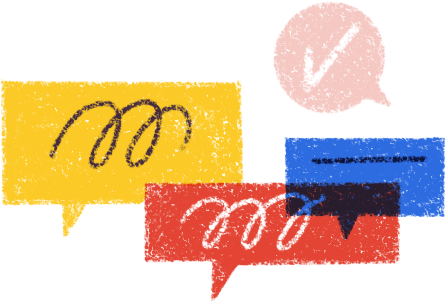The remote work sales pitch promises reduced commute times, increased flexibility, and decreased distraction in the absence of noisy open offices. At fully-remote companies, team members trade in their ID badges for the opportunity to work from home, craft the perfect productivity routine, and balance life and work from anywhere in the world.
But most companies are not fully remote and have no intention to be.
Buffer’s 2020 State of Remote Work found that 43% of individuals surveyed had a workplace setup where “part of the team is full-time remote and part of the team works out of the same office”.
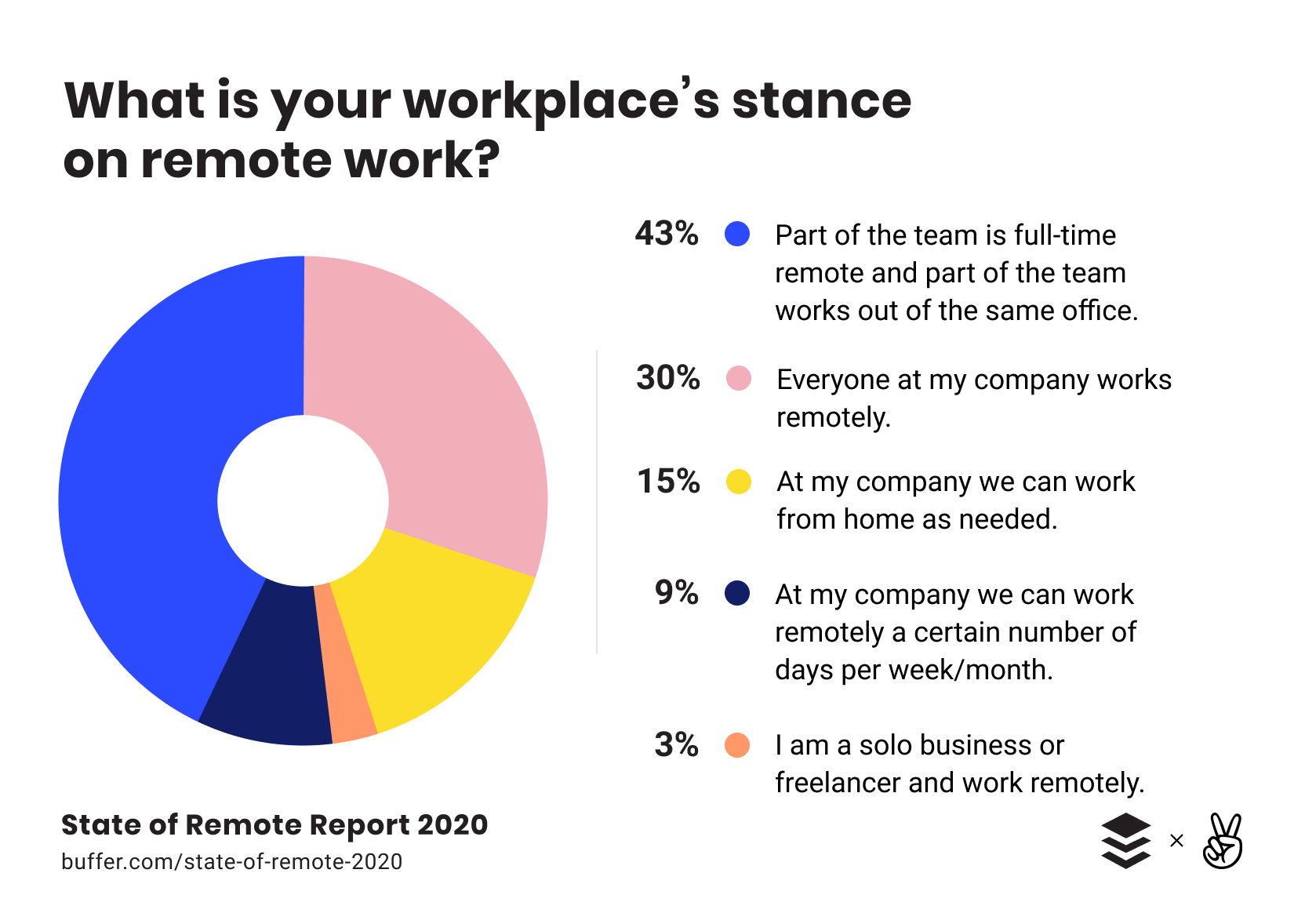
In reality, most companies embracing remote work through work-from-home policies have dedicated headquarters in cities like San Francisco and people working from home across multiple cities, countries, and continents.
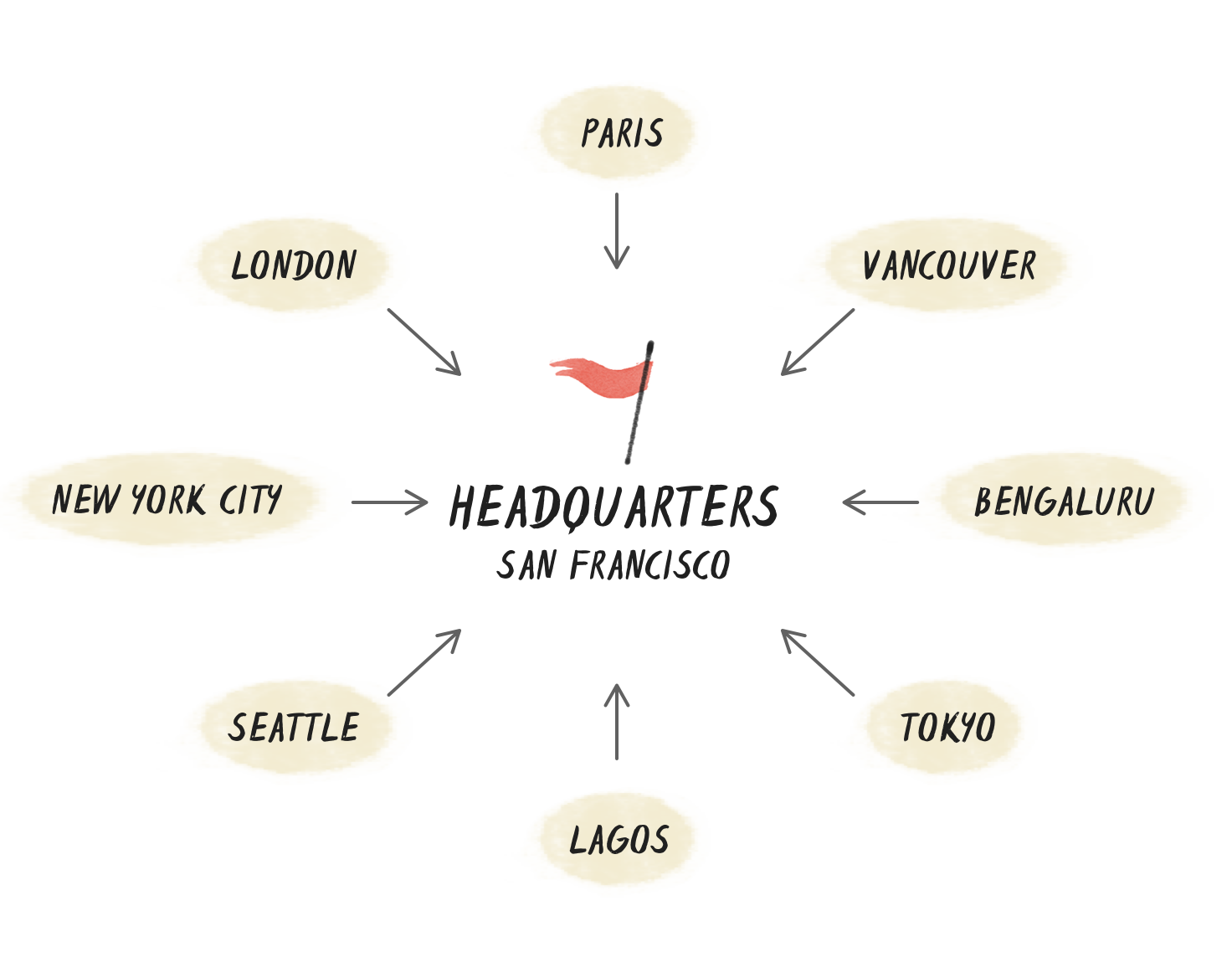
Flexible work is rising as companies recognize the benefits of having a distributed team and letting employees to work from home. These companies are remote-friendly, rolling out flexible work policies or opening remote hubs to provide flexibility, retain people longer, and expand their talent pool.
They’re not remote, they’re remote-ish.
Unfortunately, remote-ish teams confront even more communication and collaboration challenges than fully remote ones. Information gets siloed in offices while remote employees are left in the dark. Companies might hire around the world, but conform to HQ time in PT or EST, leaving their Australian colleagues to work around the clock to keep up. The result is an unintended hierarchy where office workers are naturally heard, recognized, and promoted –– while remote workers are left out.
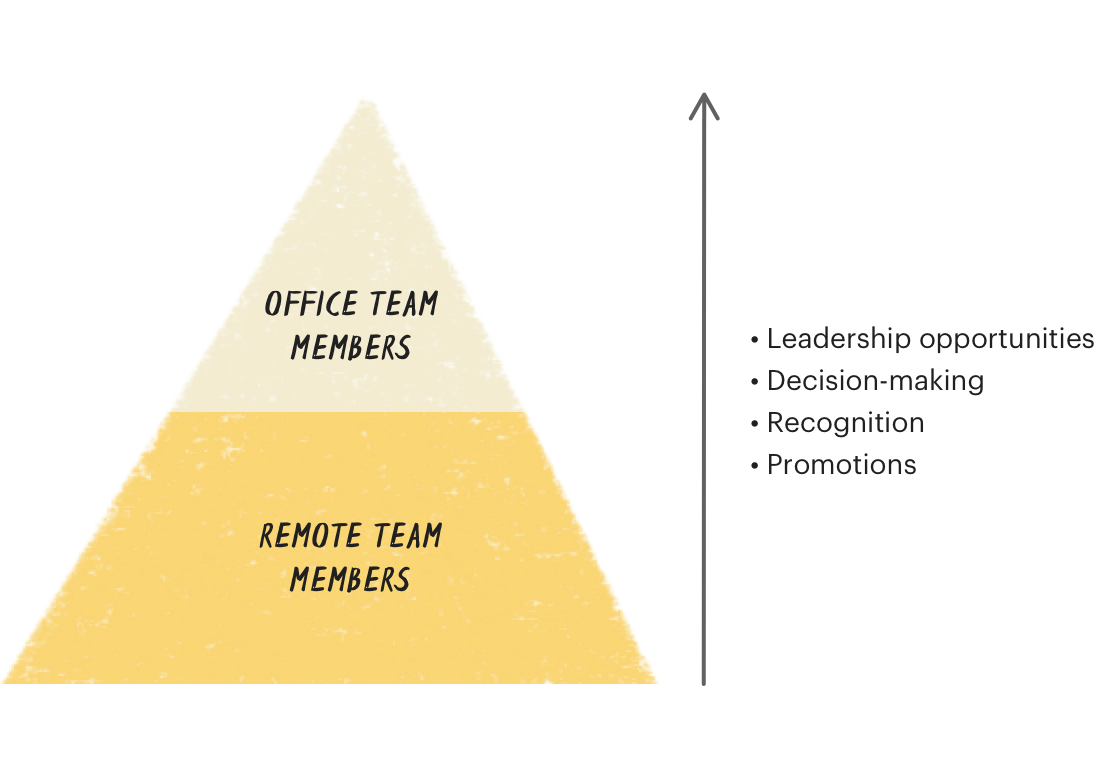
This path ensures remote work never truly gets off the ground in a meaningful way, eroding the benefits of having a distributed team in the first place. Fortunately, there’s a way for remote-ish teams to thrive:
While all companies embracing remote work can’t be fully remote, they can be remote-first.
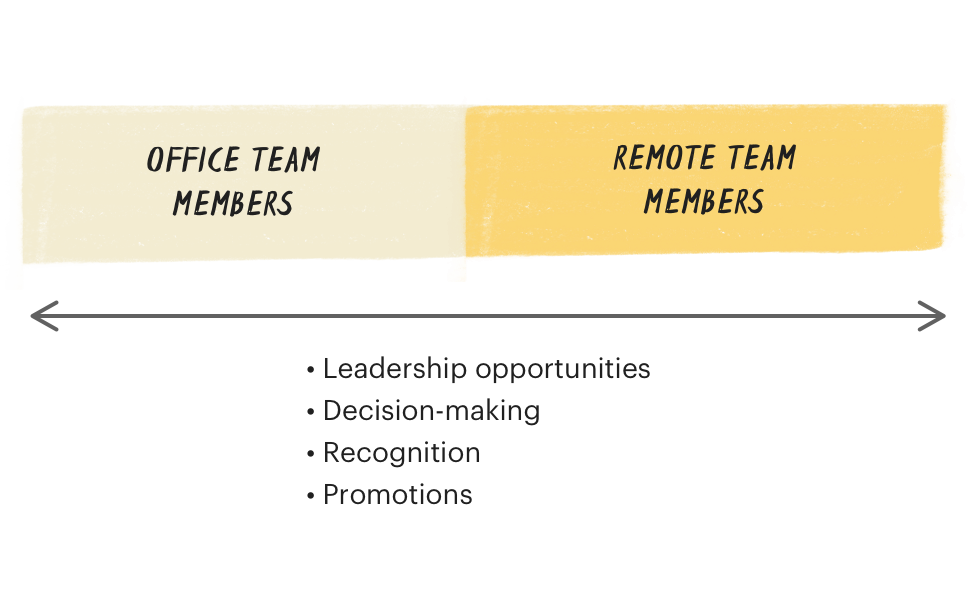
This handbook on “remote-ish” teams will provide guidance for adopting remote-first principles and policies that put everyone on the same playing field. At Doist, we’ve been a fully remote team with direct experience being remote-first. We’ll share our best practices for making sure everyone’s connected, regardless of their time zone. However we’re not remote-ish and have blind spots on this subject. We’ve called on our friends at remote-ish companies like HubSpot, Loom, HashiCorp, MURAL, Owl Labs, and Distribute Consulting to fill in the gaps and lend their advice on operating remote-first while maintaining offices.
We’ll explore optimal ways for remote-ish teams to communicate and operate as a team, so everyone does their best work. You’ll walk away with advice for structuring a distributed team, implementing remote-first policies, communicating across country lines, and working together regardless of location.
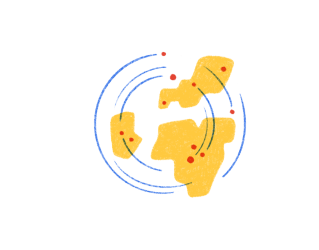 Remote-ish Benefits
Remote-ish Benefits
More and more companies are extending a “choose your own adventure” option for current and prospective employees: work from the office or work from home. Why are previously office-based companies increasingly adopting remote work and work-from-home policies?

Remote Work and Inclusion Program Manager, HubSpot
HubSpot has had remote employees for over ten years, but in recent years our remote population has significantly increased from a handful of folks to over 400 globally. From the very early days, remote work has allowed us to attract and retain the best talent as well as support our employees to work where they work best and that continues to be the driving force behind our enablement of remote work.
This section will explore why teams are giving employees the option to work where they want and the benefits they experience when they expand their hiring pool beyond their city or state.
Greater access to talent
Talent is evenly distributed, while opportunity is not. Ambitious companies have lofty goals of building the tools, technology, and services of the future. To do so, they need the help of ambitious and skilled people. Unfortunately, most of these companies are constrained by their local talent.

In saturated markets like San Francisco, New York City, or Boston, it can be difficult to attract and retain top employees. Some of the best companies in the world are leaning on remote work to meet their demand for talent.

Remote Work and Inclusion Program Manager, HubSpot
For us, having remote workers is business critical. From an employer standpoint, research has shown that when employees work remotely, they are more productive, efficient, and are overall less stressed. In addition, by supporting remote work, we’re able to significantly increase our hiring pipeline as well as retain our employees who may need to move beyond commuting distance at some point (or who simply prefer to work outside of the office). From a business standpoint, having remote employees allows us to solve for our customers by allowing us to build a global team with diverse backgrounds, who can be available for our customers in multiple time zones, languages, and specialties.
Similarly, in 2019, Stripe announced that their fifth engineering hub is remote, kicking off an initiative to hire 100 remote software engineers across North America, starting with the US and Canada. They cited several key business drivers behind the decision:
The ability to hire broadly and tap into the “99.74% of talented engineers” living outside their usual hiring hubs
The exceptional performance of their existing remote workforce
The benefit of having remote employees who are everywhere their customers are
The advances in virtual communication and collaboration that support remote work
We’ll likely see more companies follow suit and seek out prospective employees regardless of their time zone.

Head of Culture and Collaboration, MURAL
We've definitely experienced the benefits of being a global, multicultural team. Not only does it enrich our perspectives when building our product or supporting our clients around the world, it also lets us hire the best talent, regardless of where the person is located. Our software is all about fostering visual collaboration across distances. Practicing what we preach is the best way to understand what other companies might need when transforming toward new ways of working.
Hiring remotely isn’t without its challenges. Review our digital handbook on Remote Hiring for advice on sourcing, interviewing, and closing talented candidates around the world.
Increased employee retention
Even the companies billed as the best in the world have trouble retaining their employees. Amazon has a median employee tenure of 1.0 years, while Google fares only slightly better with a median employee tenure of 1.1 years.
On the other hand, remote companies often see tenures three or four times those rates. At Doist, we’ve seen a 92.8% retention rate over 10 years. More than 50% of Doisters have been with the company for over four years. Other remote companies have seen the same success in keeping their team members onboard. Buffer has a retention rate of 94% and an average tenure of 2.9 years, GitLab’s retention is 85%, BuySellAds is 90% and Zapier’s is 94%.
We’ve observed a few reasons why remote-first teams retain their employees longer:
High-trust cultures. At remote companies where looking over someone’s shoulder isn’t feasible, managers frequently opt for trust instead of micromanagement. Team members are extended trust from day one and given all the tools they need to do their best work. Instead of secrecy and hierarchy, remote-first teams default to transparency and autonomy. High-trust environments are known to generate a 50% lower turnover rate compared to low-trust cultures.
Flexibility. Remote work is where work and life find balance. Without a commute, people have 1-2 additional hours each day to use as they choose. In the absence of “9-5” work hours, individuals can lean into their morning bird or night owl tendencies or adjust their schedules to accommodate family needs or personal priorities. Flexibility can be particularly important for retaining parents, primary caregivers, military spouses, and people with disabilities. Flexibility goes beyond work hours and schedule structure, extending to where you live. Remote workers can opt out of expensive city hubs and live where they want, often near immediate family in smaller cities or towns.
Calm environments promote productivity. Constant work chat pings and shoulder-taps are relics of the office that remote employees are often happy to leave behind. By trading calendar-fragmenting meetings for asynchronous communication, remote workers can perform at the highest level by swapping shallow work for deep work and distraction for focus.

Head of Marketing, Doist
Most of the aspects that contribute to high employee retention are things that any company can do. Founders and managers that approach leadership with openness and methodical intentionality can begin to implement these sought-after elements of remote work relatively painlessly. Replicating them in a way that results in higher retention, though, is a lot more complex than just letting people WFH on Fridays. Be intentional about building implicit trust, providing autonomy with accountability, and cultivating a welcoming, unique culture.
Additional cost savings
Remote work can reduce operational costs, particularly the high cost of real estate in expensive tech hubs. For instance, the annual real estate cost per employee is $14,000 in New York and $13,032 in San Francisco.
On the other hand, remote companies often adopt a remote work salary formula that factors in location and ultimately reduces the cost of salaries. Remote teams like Buffer and GitLab have publicly shared their salary calculators. Buffer’s calculator includes a base salary for specific roles and a cost of living multiplier. There are higher multipliers for cities like San Francisco and lower multiplies for cities, states, and countries where the cost of living is less; most cities are classified as “average cost of living”.

While cost savings can be a consideration for expanding remote work at your company, it shouldn’t be the sole or most important factor. As remote work expands, we’ll likely see the development of global salary standards. It’s also important to remember that remote work has its own unique costs for companies including remote work perks (e.g. home office stipends, high-speed internet subsidies), company-wide retreats, and potentially, increased employee-sponsored travel.
 Company Structure
Company Structure
If you’re convinced of the benefits of remote work, it’s also worth considering how your company should be structured. This is an important starting point as you define how your team operates, where in the world you hire, and what new employees can expect when they join your team.
Location-specific remote work
“We hire remotely” is a loaded phrase that might signal one thing but mean another. In establishing remote structure, consider exactly where you’ll let people work from.
Product Tip
Review our handbook on Remote Setup: The Remote Guide to Logistics for more insight on the logistics of hiring in different states and countries, including employment regulations and laws regarding incorporation.
WFH-friendly HQ Model: In this model, a company has a single office in one city or state. They have a remote work policy that allows employees to work entirely from the office, entirely remotely, simply work from home they choose. This model allows remote work, but only for people within the same city the office is based. Communication is generally easier because everyone is in the same time zone. Only hiring laws of your state apply.
Country Model: In this model, a company has one or multiple offices in the same country and allows people to work remotely wherever they might be based in the country. For instance, a company may have headquarters in Los Angeles, California and Austin, Texas but also hires people who work in Santa Fe, New Mexico or Chicago, Illinois and lets them work from home. Communication complexity increases as the number of time zones increases. This model can be slightly more complicated from a logistical standpoint as different state laws are considered.
Time Zone Model: In this model, a company has a central HQ but their hiring and operations span multiple countries as long as employees adhere to certain work hours. For instance, a company may only want to hire for time zones spanning PT to ET, hence hiring in the United States, but also opening hiring toCanada, Mexico, Brazil, and Chile with similar time zones. With this model, companies enjoy the benefits of an expanded talent pool and real estate cost savings. However, communication challenges are still limited because hiring is based on operational time zones.
Global Model: In this model, a company hires from across the world without work hour requirements. A company might have one or more headquarters but also allow hiring across countries anywhere from France to the Philippines. In this model, logistics can be challenging –– laws in most countries have yet to catch up with a global remote workforce. Additionally, this model has high communication complexity and requires an asynchronous-first communication strategy to be truly successful. However, this model is most effective for sourcing talent from around the world and potentially seeing cost savings.
Here’s how we can summarize these pros and cons across the different location-specific work schemes:
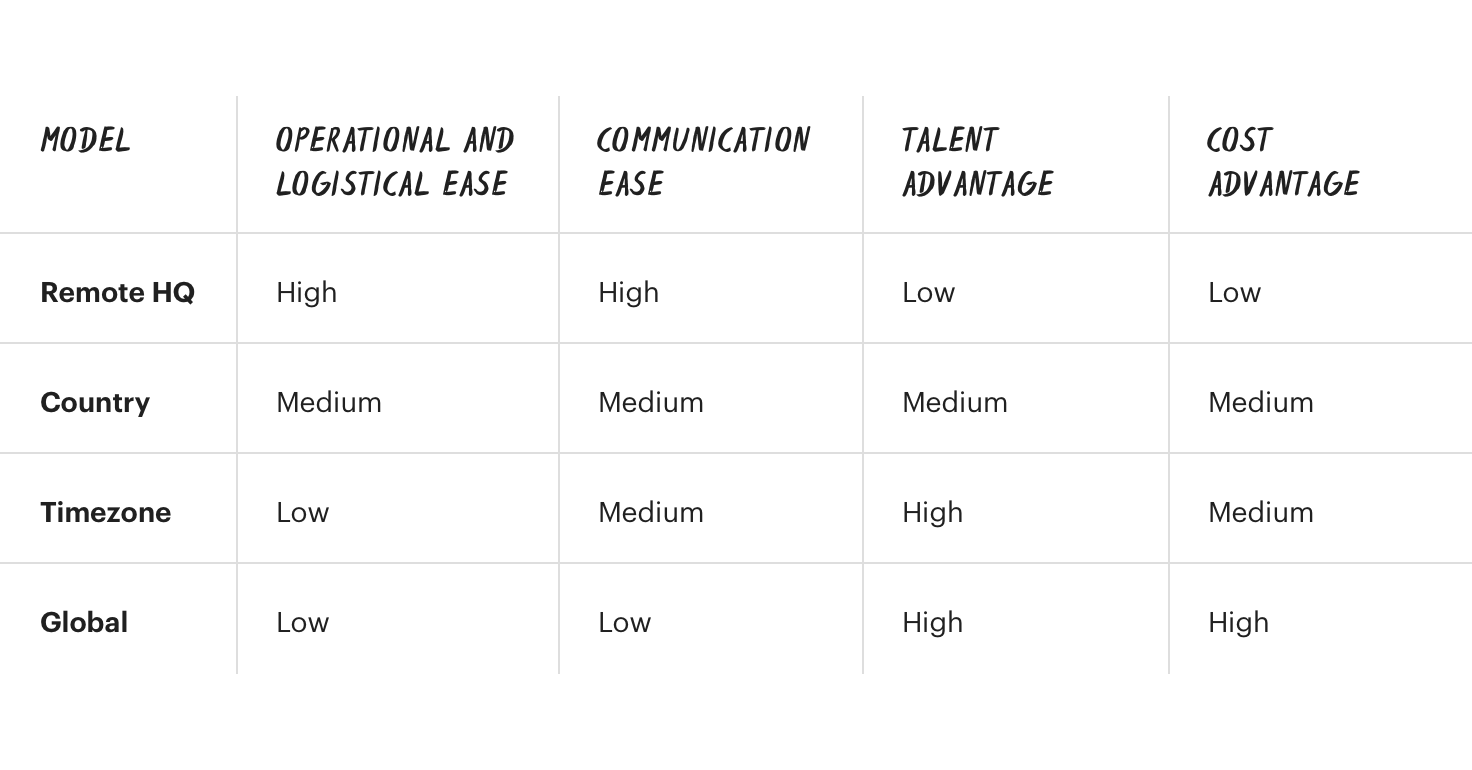
By defining what kind of remote-ish company you are and where you operate and hire from, you’ll be better equipped to build policies around your specific set of requirements. This will help you build hiring plans, forecast leasing and buying needs, and stay abreast of laws and regulations in the areas of the world you hire from.
Role-specific remote work
While some remote-ish companies arrange their operations based on country and time zone, others opt to operate remotely based on specific roles. The remote-ish team at HashiCorp abides by this model, while still maintaining a remote-first way of working:

Co-Founder and CTO, HashiCorp
For the SF Office, we have a relatively small footprint, only 20% of staff are there. In general, the teams there are very centralized (HR, legal, finance, IT). The teams that are more decentralized have very few people in the SF office. That said, most of the time meetings in SF also have a zoom call attached and all the conference rooms have an AV setup for that. We try to think about "remote first" and stick to that even in the office.
Central HQ, some departments remote: Some companies are co-located, but allow one or more departments to work remotely. For instance, some companies hire fully remote customer support teams. This allows them to have around the clock customer service for their global customers. The team at Shopify is headquartered in Ottawa, ON with offices in San Francisco, CA and Singapore. However, they have a fully distributed customer support team with over 2,000 team members. However, in 2020, they announced they’ll actually be a fully remote company.
Remote, Some departments in HQ: On the other hand, some companies are fully remote but keep certain departments co-located. This can be the case for sales and business development teams who might need to take in-person meetings to land larger contracts in major city hubs. For instance, InVision is a fully remote team with offices in Boston and New York that are mostly populated by sales and business development team members.
Companies can organize remote work around location or department, as long as they’re intentional and transparent with their teams and potential hires.
 Remote-Friendly vs Remote-First
Remote-Friendly vs Remote-First
As companies recognize the benefits of being a remote-ish team and begin introducing remote hiring and remote work policies, the single biggest mistake they can make is opting to be remote-friendly instead of remote-first.

Senior Director of Brand, Loom
Companies that have both remote and location based employees should adopt a "remote-first" mentality. Always make sure there is video-conferencing available and try to avoid hallway decision making. Fully remote companies should be very specific about addressing potential pain points in remote work rather than accepting as fact that remote automatically is better than a centralized workforce. That's the biggest issue I've seen. That companies will blindly accept the notion that "remote is the future of work" without actually doing the work that it takes to ensure it works for everyone.
In this section, we outline the difference between the two modes of operating.
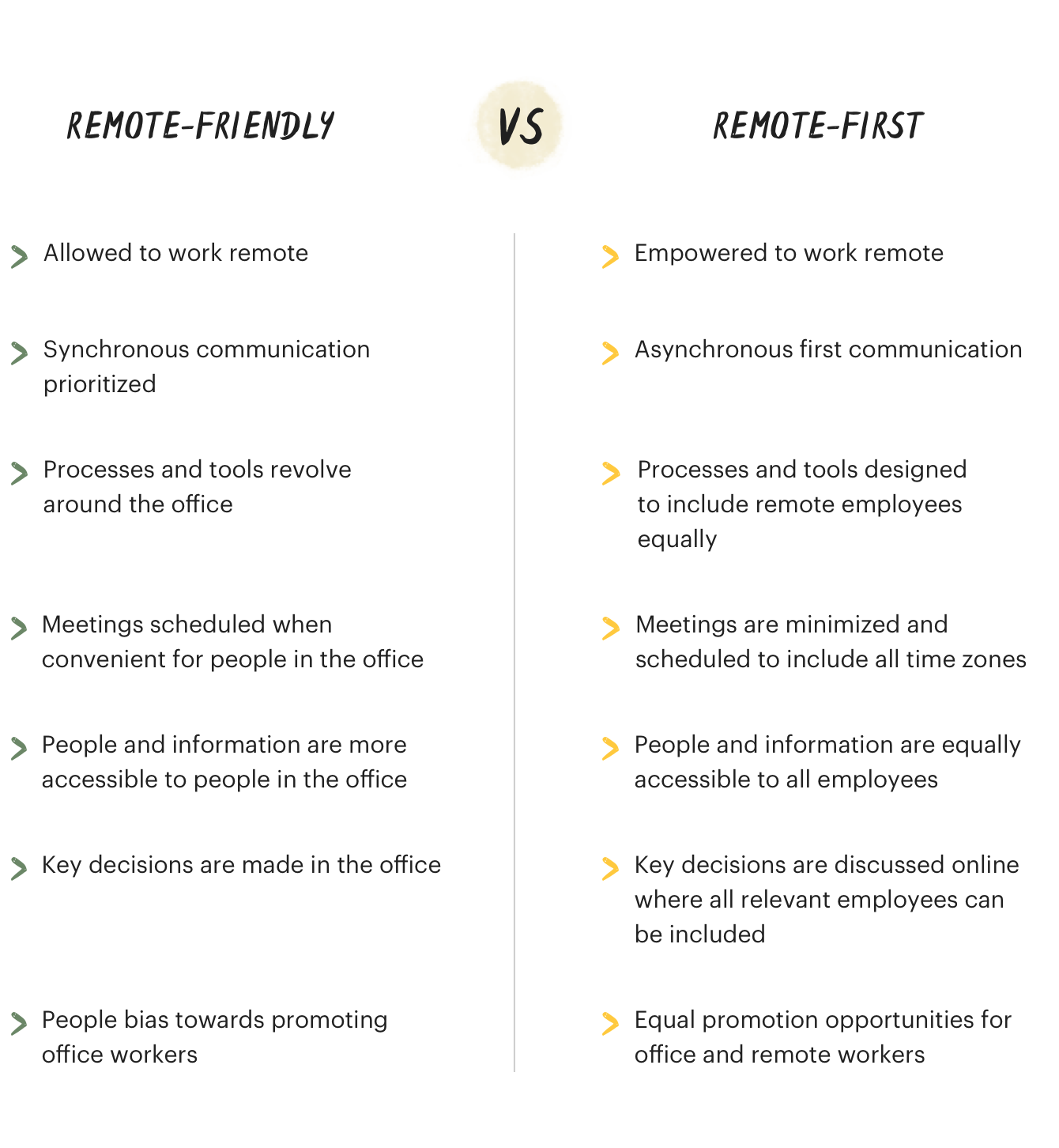
Remote-friendly companies
Though remote-friendly companies allow remote work, they don’t optimize for it. Instead office employees and remote employees are not properly integrated and exist on two different, often unequal, tiers.
Team meetings exclusively occur in a co-located time zone
Water cooler chat is a space for key decisions
Presence is correlated with meaningful work
Communication is synchronous-first
Managers must work in the office
When these are the defaults, remote team members get left behind while their office counterparts have their presence rewarded with resources for key projects, promotions, and recognition.
Remote-first companies
Remote-first companies intentionally optimize for remote work.
Real-time meetings are kept to a minimum and recorded for all
Decisions are made online, not at happy hours
Performance is measured by output rather than hours worked
Communication is asynchronous-first
Managers are encouraged to work from home
Everyone has an equal voice and promotions can be awarded more fairly on the basis of the strength of one’s ideas, contributions, and output.

Remote Work and Inclusion Program Manager, HubSpot
In the context of a hybrid team, one of the challenges that can arise is how to ensure that our remote employees feel equally included and supported in the culture of our company. It’s not enough to simply allow remote work, it’s essential that companies focus on truly enabling remote workers, and that requires that everyone do their part to support that type of culture. Creating an inclusive culture when your team is distributed throughout the globe requires new ways of thinking, leaning into technology, and a pinch of creativity - but the results are absolutely worth the effort.
Remote-first is the gold standard for how remote-ish companies should operate. Without this operational framework, distributed companies simply have offices with isolated and distanced employees working invisibly from home. Not a good way to retain top remote talent.

Laurel Farrer, Founder and CEO, Distribute Consulting
Adjust your mindset; when one person is remote everyone is remote. Build workflows and communication structures to support equal access regardless of location.
A remote-first mentality extends to how a company operates, communicates, hires, and promotes, creating an environment that puts everyone on equal footing.
 Connecting your Remote-ish Team
Connecting your Remote-ish Team
Remote-ish teams function best when the entire company optimizes for remote work. When remote team members are an afterthought, hearing about lunch-time decisions days later, it’s hard to achieve a cohesive distributed organization. Successful hybrid teams are inclusive of their remote workers and set up processes to help them thrive alongside their office teammates.
First, leadership must acknowledge the different challenges remote workers face and meet those challenges with solutions. Sometimes this means overcompensating and leaning towards policies that specifically elevate remote team members.
When companies become remote-first, they naturally become people-first. When flexibility and consideration is given to remote workers it’s afforded to all.
This section will lend advice on making remote-ish work function well for everyone –– whether they’re in the office 9-5 or working on the other side of the world.

Laurel Farrer, Founder and CEO, Distribute Consulting
Create a remote work policy that keeps remote workers and contractors from feeling like second class team members. Communicate policies early and often.
Keep remote-workers connected with HQ
Even though remote workers might be hundreds or even thousands of miles away from headquarters, it should feel like they’re fully connected and not missing a thing. Remote-ish teams should enable remote-office connections that build rapport and enable effective collaboration and camaraderie across locations.

Remote Work and Inclusion Program Manager, HubSpot
We believe that empathy plays a huge role in creating an equal playing field for our remote employees. We encourage teams to host remote days or even remote weeks in order to better understand and empathize with the experience of being remote so that we can all do our part to create an inclusive environment.
Here are a few different ways that remote-ish teams can build bonds:
Mentorship weeks and in-person onboarding. Extend new remote team members the opportunity to meet their office peers by flying them out to headquarters for onboarding. At Doist, we have a mentorship week where new hires are flown out to work alongside their mentors. These practices build personal relationships early on that ease collaboration when people go back to working remotely.
Get office colleagues to work from home. HubSpot has work from home weeks where their Boston-based team members spend the week working from home. These weeks build empathy and understanding for the pain points of remote work.
Offer company conference perks. Give remote team members and office teammates the chance to meet and build relationships through conference and professional development opportunities. These opportunities provide shared learning experiences and build common knowledge.
Host company-wide retreats. Whenever possible, bring the entire team –– both remote and office team members –– together for a few days for a retreat or off-site. Retreats are an accelerated bonding experience for remote and remote-ish teams alike.
While these opportunities are costly and require a lot of coordination, they pay ongoing dividends by helping remote-ish teams function as a unified unit moving towards the same collective goals.
Ensure HQ workers have flexibility too
On a remote-ish team, it’s easy to see team members as “office employees” and “remote employees”. Admittedly, this is the dichotomy we’ve described throughout this guide. However, it’s important to allow flexibility for office team members too.
Create an explicit work-from-home policy for office employees that extends the benefits of remote work beyond remote employees. Clearly outline expectations of people working from home in documentation or a company handbook. Ensure your guidelines answer these questions:
Can office employees work from home any day of the week?
How many days in a row can office employees work from home?
What is the maximum number of days an office employee can work from home?
Do office employees working from home need to maintain certain working hours?
Can office employees work remotely while travelling?
Do office employees need to ask for permission to work from home?
Do office employees need to communicate that they’ll be working from home?
A flexible policy for office employees helps retain office team members and reduces any friction between remote teammates and their work-from-home colleagues.
Create differentiated policies
While treating both remote and office-bound colleagues fairly should be a priority, that doesn’t necessarily mean they should be treated the same. Depending on your remote setup, some team members may be full-time employees while others might be contractors. This often creates a legal need to differentiate how teammates receive salaries and benefits.
Legal reasons aside, there are also practical considerations for different policies for the two classes of workers. One is providing relevant and helpful perks. While paid team lunches can create bonds in an office setting, this perk isn’t particularly pertinent for at-home employees. Instead, an internet allowance for remote team members is a great perk to create a high-productivity remote work environment at home. Instead of crafting your perks and policies with exact equivalencies in mind, consider the unique needs of each group and create policies and perks that address them. The chart below shares ideas of perks that could be extended differently to each group:

Continuously evolve your company’s understanding of remote work challenges and work to actively address them in meaningful ways. Consider annual engagement surveys that ask meaningful questions about your remote-ish setup so you can refine it with new or revised policies that seek to address both remote and office team members separately and together.
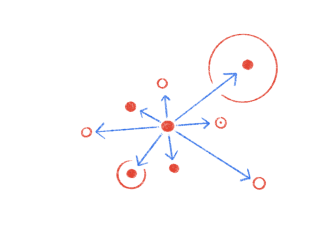 Communicating Across Countries
Communicating Across Countries
On a remote-ish team, a 1:00 PM board room meeting at headquarters in New York City is a 7:00 PM conference call for a remote team member in Madrid. While a meeting for both is possible, it certainly isn’t ideal. While one group gets back energized from lunch, the other is working late into the evening with their personal time disrupted. On the other hand, missing the meeting might mean exclusion from key decisions and a greater sense of isolation from the wider team. For team members in Taipei or Singapore, there’s no real choice to be made; it’s 1:00 AM and they’re fast asleep.
If you hire globally, time zones are the single biggest issue to overcome when it comes to operating as a remote-ish team. However, there’s a simple strategy that eliminates this hurdle and keeps team members collaborating effectively while they’re distributed across the world: asynchronous communication.
This section will discuss why asynchronous communication, a culture of documentation, and strategic synchronous communication can help remote-ish teams stay in sync.
Communicate asynchronously
Synchronous communication, conversations where a quick-back-and-forth is possible and participants are present at the same time, falls short for remote-ish teams for the reasons illustrated in the hypothetical example above. Working synchronously across different time zones favors the critical mass in the office. It puts remote team members at a disadvantage, scrambling to make early morning and late evening calls or missing out on them entirely.
It also negates one of the biggest benefits of working remotely in the first place: a flexible work schedule.
Alternatively, asynchronous communication, where participants communicate as they’re available and discussion is punctuated by intermittent gaps, serves remote-ish teams well. Team members don’t need to be online at the same time or in the same physical location to respond to emails, create conversation threads, or collaborate in cloud-based software apps like Google Docs. Instead, they can choose their own productive working hours, default to deep work, and answer messages when they’re open to being interrupted.
Remote-ish teams should adopt asynchronous communication as the primary source of correspondence to put all team members on equal footing. This means being asynchronous-first. The following table outlines some of the differences between an asynchronous-first culture and a synchronous-first culture:
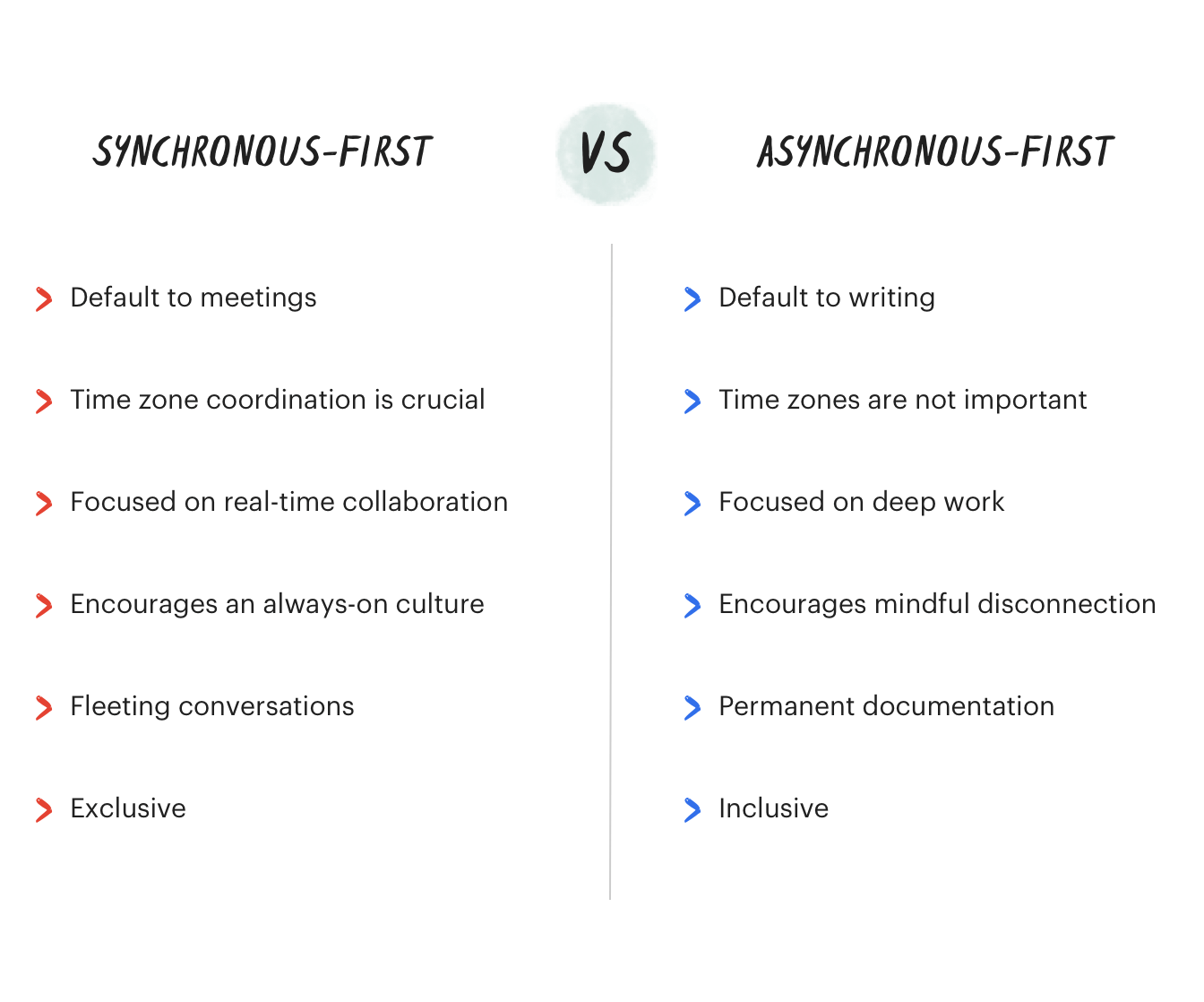
To move your team toward async, start culling synchronous communication like recurring meetings and re-imagine each of your gatherings from first principles:
What do we miss when we eliminate face-to-face conversation? Can this be replicated asynchronously?
Could a written status update replace a daily or weekly stand-up?
How could brainstorming/feedback/problem-solving/decision-making move from Zoom to a written thread?
Asynchronous-first teams don’t only benefit remote team members. For office-bound team members who are on vacation, take sick days, or simply miss a meeting, there’s a trove of written communication on asynchronous teams that anyone can refer back to. Asynchronous communication also benefits future employees who can examine a company’s communication archives and get up to speed on all things work and culture.

Head of Culture and Collaboration, MURAL
There are many best practices from distributed teams we have adopted in order to become a 'remote first' company. One of these is overcommunication. This sounds chaotic at first but it doesn't have to be. It just means that team members need to make sure they update everyone else on their team on what they're working on in an inclusive way and it's crucial that everyone follows up in the same way to ensure alignment.
Product Tip
In Twist, conversations are searchable, forever. Use the search function and query keywords to find threads dating back days or years. Alternatively, navigate to find what you need by looking through channels where conversations are easily organized and scannable.
Build a culture of documentation
When individuals and teams are striving for an important goal, it’s crucial they’re all heading in the same direction. On a remote-ish team, where close collaborators may be spread across countries, shoulder taps and quick check-ins aren’t feasible. Instead, it’s important to build a culture of documentation where everything is written down to help our future selves.

Head of Culture and Collaboration, MURAL
Documentation and transparency are critical to empower team members with the information they need to do their work. Most distributed teams spend a lot of time writing, whether that be direct messages or documenting what they do in an easily accessible knowledge base (we use Confluence). Everything needs to be written down and shared. Once documenting and sharing information in the assigned channels becomes a habit, employees are able to work more effectively and won't have to ask for information because it will already be available.
Clear and concise documentation allows remote individuals to work more independently without having to wait on an answer from their manager on how to do something. On team projects, documentation can serve as both a source of truth and a living document that’s improved upon by a group.
Here are a few important areas where centralized and accessible documentation should exist:
Company policies, core values, and operating principles
Project management system guidelines
Critical service outage instructions
Technical implementation resources
Product and project roadmaps
Career development paths
Aside from official documentation, that’s often stored in a precise location for reference, it’s important to also document decisions and next steps in writing. Sometimes in-person chats and quick Zoom calls are unavoidable. In these cases, it’s crucial to maintain an asynchronous-first mindset and document decisions clearly and concisely afterward, particularly if they were made offline.
Product Tip
In Twist, use close threads to highlight a conclusion or document a resolution with the “Closed Threads” feature. This creates transparency and lets everyone know when and how a decision was made.
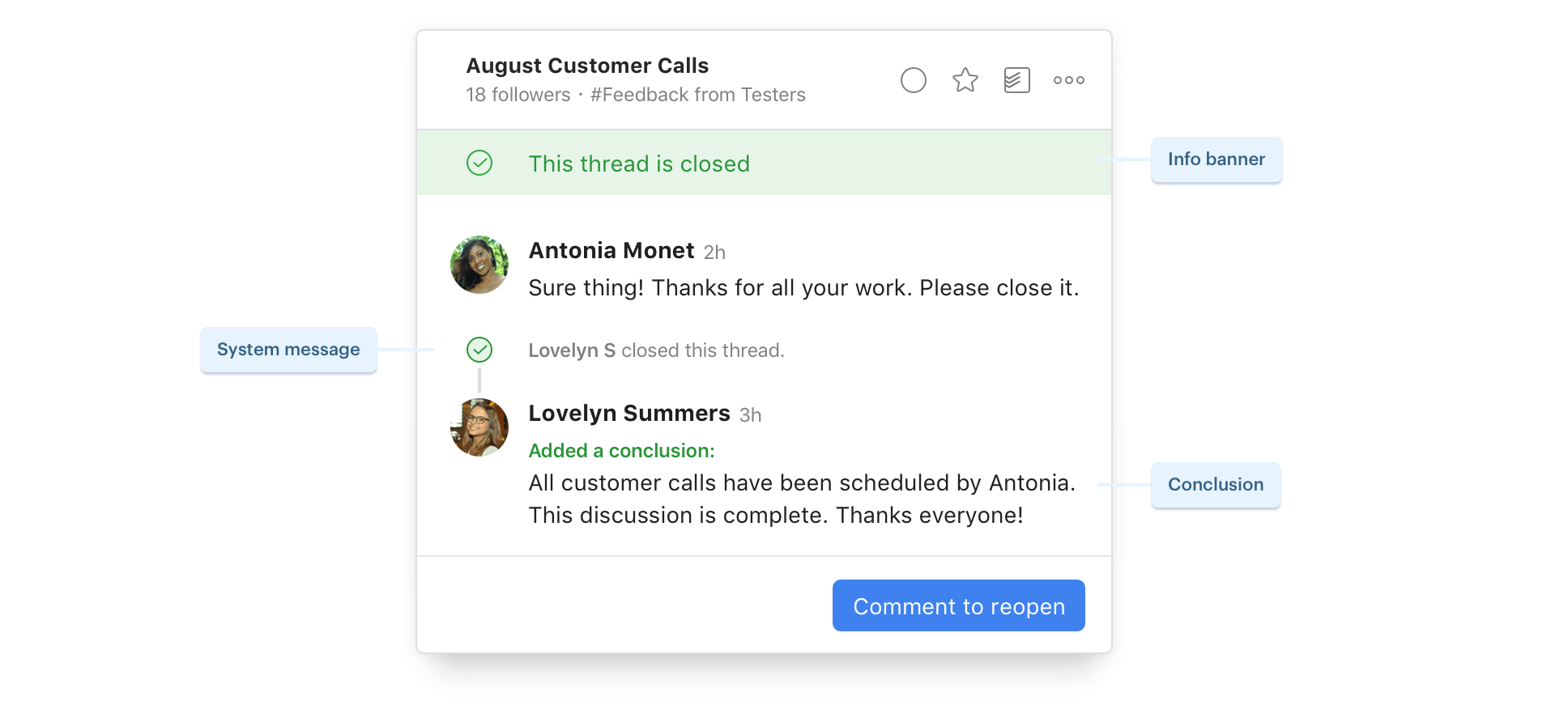
Become a company where most questions can be answered by linking to an online thread and unknown answers are found and documented straight away. Build a culture based on writing, where concise remote writing and strong communication are highly valued.
Make synchronous communication accessible
While we recommend asynchronous-first communication, video calls and other forms of synchronous communication have their place. In these cases, make synchronous communication available asynchronously to help remote-ish teams function their best.

VP Marketing, Owl Labs
In meetings, we are always on the watch to make sure there is equal opportunity for remote and in-room participation. This is a practiced skill across our team, and most often it's the responsibility of the meeting organizer to keep an eye out for the remote folks. Sometimes you can tell someone is interested in saying something and hasn't yet. As an in-room participant, you can advocate for that individual to help them enter the conversation. The Meeting Owl is a key tool for including our remote folks. It's a 360° conferencing camera that helps you see and hear everything that's happening in the room, so you feel like you're there.
Be mindful of time zones. For occasional synchronous meetings, use meeting time zone tools like timeanddate.com to find a time that’s reasonable for everyone. Naturally, with enough countries represented, the meeting time will be less convenient from some. In the interest of fairness, make sure ideal time slots are rotated between team members so it’s not always the same people making compromises.
Call in to meetings individually. When there are company-wide calls, office team members often gather in a conference room and remote team members call in from home. Instead, try having everyone call in from their respective desks and computers. This eliminates side conversations and office banter that can often be hard for remote team members to follow and contribute to.
Record video calls. Unfortunately, sometimes a meeting simply can’t be attended. Default to record all video conversations and make them available for viewing later in a central place for all team members. For instance, the team at GitLab has a YouTube channel, GitLab Unfiltered, where they centralize many of the company’s recorded video calls.

Remote Work and Inclusion Program Manager, HubSpot
At HubSpot, we believe that remote inclusion is everyone’s job. So whether you’re hosting a major event on site or just having a chat amongst your co-located team members, we ask that everyone be mindful of team members who aren’t physically present and encourage conversations in a channel where everyone can participate, such as Zoom. Ideally, these conversations can happen with everyone logged in individually so that we create an “equal playing field.” However, when this is not possible, we train our managers on various ways to create an inclusive meeting environment when the audience is distributed. For example, we encourage asking remote team members in advance how they prefer to participate in meetings, we try to balance the conversation by having the leader of the meeting log in remotely, and we encourage that everyone be mindful of taking longer pauses to allow for input from remote team members.
By adopting asynchronous-first communication and building a writing culture, remote teams can sidestep the challenges that come with time zones and find ways to collaborate effectively across continents on work that matters.
 Working Together
Working Together
When everyone is working together on a big project in the same place, the rules of collaboration can be less precise. The ability to swing by someone’s desk to get clarification gives teams leeway to not have operating guidelines for collaborating on projects. When you’re not in the same city, much less the same building, more explicit processes and expectations need to be established to keep everyone moving in the same direction.

VP Marketing, Owl Labs
First and foremost, working distributedly requires strong mindfulness for your fellow teammates. After that, it requires a whole set of tools and skills to make sure all employees, no matter if they are right next to you or a thousand miles away, are set up for success. This extra effort is a disadvantage now, only because we're still on that learning curve. Soon it will be easy and instinctual.
This section will provide tactical suggestions for collaborating effectively on remote-ish teams in order to bring ambitious projects to life without running into common pitfalls like accountability voids, missed deadlines, and frustrated team members.
Implement radical transparency
On co-located teams, a lack of transparency makes work more challenging for everyone. Whether information is purposefully obscured by gatekeepers playing office politics or isn’t shared out of casual disregard, opaque organizations slow down work. On a remote-ish team, it can stop work entirely.

Laurel Farrer, Founder and CEO, Distribute Consulting
Hybrid team models can be challenging for teams because it can feel like you are managing the complexities of two separate work models, remote and co-located. One of the most common missteps we see in hybrid models is not making communication channels or information transparent and accessible to remote workers, creating an inequitable environment that leads to decreased productivity and employee satisfaction.
Build a remote-ish culture that defaults to transparency. Everyone should have access to the information they need to do their job.
Aside from operational efficiency, transparency also breeds trust. For remote team members, it’s easy to wonder “Is there information everyone knows that I don’t?”
When transparency is embedded in a distributed team’s culture, remote team members can expend less emotional energy on what they might be missing and focus on the work in front of them.

VP Marketing, Owl Labs
Transparency is crucial. It's important that all information, data, and plans are equally available no matter if you're in the office or remote. We rely on digital planning tools, wikis, and more. Knowledge needs to be equally accessible everywhere.
Here are a few areas where transparency goes a long way:
Your company’s revenue, growth, and profit numbers
Most internal correspondence (e.g. exceptions for personally sensitive information)
Information on promotions, pay increases, and career ladders
Company or departmental spending
Employee departures (with respect for sensitive information)
Product and service roadmaps
By opting for transparency, everyone has clarity on the current state of the company and can perform their job with the most up-to-date information available.
Value output over input
A feature of office culture is performative presence. Employees try to impress by arriving before their boss and leaving only when their manager has departed. In these always-on cultures, employees feel pressure to provide quick responses and get work done during evenings and weekends, signalling “hard work”.
This pressure can be especially strong for remote team members on a remote-ish team. To combat the ethos of “out of sight, out of mind”, employees working from home may be constantly on the clock, responding to messages and revising documents outside office hours to compensate for their lack of physical visibility.
An input-based culture, where presence is the priority, is a disadvantage for everyone. Showmanship is prioritized over workmanship and visibility becomes more important than effectiveness.
For remote-ish setups to work, companies need to shift their mindset from input-based to output-based. In an output-based company, the hours you work and how much time you spend online is immaterial. Instead, performance is measured on the quality and quantity of the work you produce.

Remote Work and Inclusion Program Manager, HubSpot
Our Management and Leadership team has created dedicated training for our manager community to approach management with a focus on results versus presence. Remote employees and office employees are both judged on the work they produce rather than the number of hours they work. In addition, we arm our managers with best practices for building psychological safety, setting expectations, and creating inclusive meetings so that they can create an environment for remote employees to thrive.
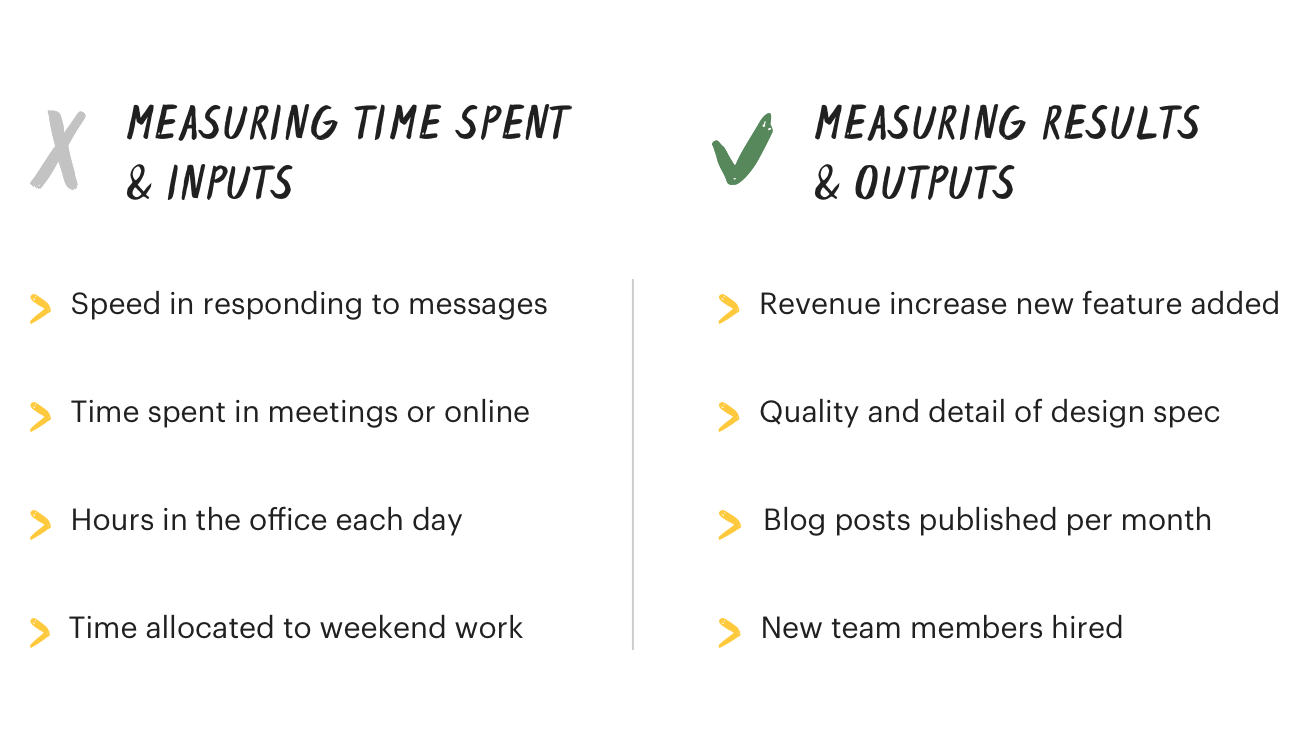
When recognition, promotions, and a job well done is based on outputs, incentives change for the better. Employees prioritize deep work to execute on their best ideas. Team members care less about when they work and more about what they work on. You’re left with a culture that favors do-ers over seat-fillers.
Plan everything
Projects simply go more smoothly with planning. However, on a remote-ish team, clear planning becomes an absolute necessity for keeping everyone on the same page. Planning should be a central part of everything from designing a new feature to preparing a product launch.
Having defined project plans that are kept up-to-date helps everyone understand next steps in the absence of verbal status updates or casual side-conversations. The best plans also make room for inevitable changes and clearly communicates them to everyone involved as early as possible. Planning is best done with centralized tools that everyone has access to.
Project management tools, like Todoist, help with planning projects and defining phases and next steps that everyone has access to.

Knowing that a project will take three months is nebulous and unclear. On the other hand, having a project broken down by weeks, with action items and milestones, keeps a remote-ish team moving forward regardless of their location.
Create accountability & trust
Having a plan in place is important; having accountability about what role team members will play is even more crucial. In a remote-ish setting, individual responsibilities and project expectations should be explicit.
In the absence of someone raising their hand in a meeting to take on a responsibility, remote-ish teams should have clear ways to define who does what and where accountability lies when it comes to both small tasks and big projects.
[Screenshot of new Task details with someone assigned]
Have a project leader. Even in low-hierarchy organizations, projects don’t run themselves. Have a dedicated project leader or project manager who’s responsible for driving a project forward. This person might be in charge of creating a spec, setting a timeline, assigning specific roles, and ensuring a project meets its milestones, deadlines, and targets.
Delegate specific responsibilities. Each task that’s part of a larger project or process should be attached to a specific person or Directly Responsible Individual (DRI), a term coined by Apple indicating who is ultimately accountable for something. Make no assumptions regarding responsibilities. Formally assign work through project management tools that help create transparency regarding who does what.
Regular status updates. Continuous accountability and follow-through can be the most effective way to build trust on remote-ish teams. Use regular asynchronous status updates to keep everyone up to date on progress. For status updates, ask each member of a project to share what they’ve completed, what they’re working on next, any challenges they’ve faced, and any roadblocks they see ahead. This is also an opportunity to share mistakes made and seek out help or clarification.
Product Tip
For a full guide on taking remote projects from start to finish, read our online handbook, Remote Projects 101: The Remote Guide to Project Management, which features advice from remote and distributed teams like UiPath, Clearbit, Doist, Hotjar, and more.
Choose the Right Tools for the Job
The right process needs to be married with the right tools to bridge the gap between the office and remote workers. The design of a tool will dictate how it’s used. That’s why it’s important to intentionally choose tools that align with the way you want your team to collaborate.
These are a few guidelines for choosing tools on a remote-ish team:
Find cloud-based tools instead of locally installed software. When everyone is co-located, software installed locally by IT can be appropriate. However, when your “workspace” spans both a headquarters and dozens of home offices, choosing cloud-based software is a must. This is the difference between using Microsoft Word vs Microsoft Word Online or Google Docs. With the right authentication, everyone should have access to whatever files they need online whether they’re in a boardroom or working from the couch. Files should update in real-time as people collaborate on them across time zones.
Opt for high security tools. Using cloud-based tools can leave companies open to potential security threats. Do your research and use tools you trust and create security barriers through measures like two-factor authentication. Doist’s Security Checklist for Remote Workers shares steps that can reduce the risk of security breaches while working online.
Choose tools that respect attention. Presence indicators, line-by-line messaging, and addictive UX are enemies of focused work and asynchronous communication. Chat-based tools like Slack prioritize real-time messaging and quick, adhoc chats over asynchronous updates and written documentation that can be referred back to later. In contrast, thread-based messaging apps like Twist allow for longer-term discussions organized by topic that can be cross-referenced and linked back to later, automatically building your team’s knowledge base.
Use software with rich collaboration features. One of the first questions about remote collaboration is, “how do you brainstorm and collaborate?”. In-person, brainstorming and collaboration happens on white boards; remotely it happens on digital canvases waiting to be filled. Tools like Dropbox paper and Figma provide a feature-rich canvas for team members to share their best ideas and provide feedback with targeted comments that can point to an out of place pixel. For collaborative editing, Google Doc’s “suggesting” mode can’t be beat.

 Conclusion
Conclusion
In light of the 2020 global pandemic, companies like Facebook, Twitter, Square, and Shopify have already declared their intent to allow their employees to work from home, forever. As we see more and more of these hybrid teams emerge, it’s the companies who intentionally embrace remote-first policies and asynchronous-first processes that will succeed in the long-run.
Bridging the gap between employees in the office and those working elsewhere is a process that requires constant iteration. It means finding and creating flexible tools and processes that work for everyone. While this process to accommodate will be challenging at first, teams that design flexibility for some and extend it to all are poised to succeed as we enter the future of work.

